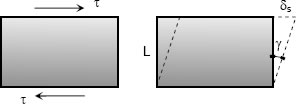Solution to Problem 224 Triaxial Deformation
Problem 224
For the block loaded triaxially as described in Prob. 223, find the uniformly distributed load that must be added in the x direction to produce no deformation in the z direction.
- Read more about Solution to Problem 224 Triaxial Deformation
- Log in to post comments
Solution to Problem 223 Triaxial Deformation
Problem 223
- Read more about Solution to Problem 223 Triaxial Deformation
- Log in to post comments
Shearing Deformation
Shearing Deformation
Shearing forces cause shearing deformation. An element subject to shear does not change in length but undergoes a change in shape.

The change in angle at the corner of an original rectangular element is called the shear strain and is expressed as
The ratio of the shear stress τ and the shear strain γ is called the modulus of elasticity in shear or modulus of rigidity and is denoted as G, in MPa.
The relationship between the shearing deformation and the applied shearing force is
where V is the shearing force acting over an area As.
- Read more about Shearing Deformation
- Log in to post comments
